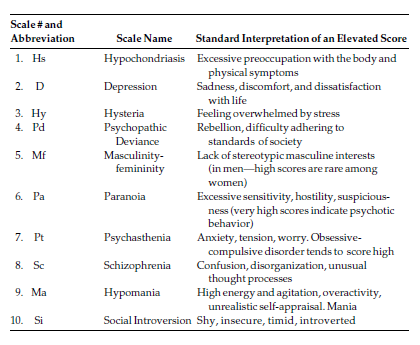The MMPI-2, the latest version of the Minnesota Multiphasic Personality Inventory, is currently the world’s most widely used instrument for diagnosis of psychopathology. Originally published in 1943, the MMPI is a 567-item, true-false test that was designed as an aid to psychiatric diagnosis. It produces scores on ten clinical scales, and elevated scores on these scales are then examined to produce a diagnosis. Descriptions of the scales appear in the table below:
Table 2.

Scoring and interpretation of the MMPI often involves classifying the profile as belonging to a code type, consisting of a combination of two or more clinical scales elevated beyond a certain level. Many code types have been identified with particular disorders and extensively studied. The 49 code type, consisting of elevations on 4 (psychopathic deviance) and 9 (hypomania), for example, has been found to be highly characteristic of antisocial personality disorder. Code type 12 (elevations on 1, hypochondriasis, and 2, depression) is typical of the classic hypochondriac. Such types have been identified for most common disorders.
In addition to the clinical scales, the MMPI also features four validity scales, which allow the examiner to detect people who are faking or malingering, as well as those who may not be able to read or understand the test sufficiently. The L scale, for example, was designed to catch people who are answering dishonestly and evasively. It consists of fifteen items, which, if answered “False,” indicate a very unlikely level of personal virtue (e.g., they never get angry, they like everybody they’ve ever met, they never lie, and they would rather lose than win).
Unlike most psychological tests that are usually grounded at least somewhat in a theory, the MMPI was created through an approach called criterion-keying. The designers of the test gave thousands of test items both to well-defined clinical samples that included a group of depressed patients, a group of schizophrenics, and so on, and to a control group made up of non-patients. They then examined the results for items that were endorsed by the clinical samples significantly more or significantly less frequently than the control group. All items that didn’t reliably distinguish the controls from the other subjects were thrown out, leaving the final pool of items used in the test. For example, questions do not appear in the schizophrenia scale because they express thoughts characteristic of schizophrenia; to the contrary, they appear there only because schizophrenic patients usually answer them differently than people who are not mentally ill.
The current version of the test is known as the MMPI-2 because of a major overhaul and revision that was published in 1989, after nearly a decade of work. There were several reasons why the revision was necessary, but a major concern involved the representativeness of the original standardization sample. The test was originally devised at the University of Minnesota Hospital, and the control group consisted primarily of relatives and visitors of the patients who made up the clinical samples. This being Minnesota in the 1940s, all of the control subjects were white, married, from a small town or rural area, and had an average of eight years of formal education, and were therefore not an especially good representation of the U.S. population.
Item content was also troubling, because many items contained archaic references (to such things as sleeping powders and playing “drop the handkerchief”), which rendered them incomprehensible to modern readers. Some items were simply offensive, including sexist language, references to bowel and bladder function, and references to religious belief, which so offended some test takers that they filed lawsuits over them. Furthermore, the method by which the test was created involved little editorial oversight, and many items therefore included poor grammar and inappropriate punctuation.
Concern also had arisen that the MMPI items were inadequate to assess the various disorders that had entered the lexicon of psychology and psychiatry since the test was first published. The test lacked items about drug abuse other than alcohol, for example, and failed to address suicide attempts. The MMPI-2 takes care of all of these concerns and was standardized on a sample that is far more representative of the U.S. population at large in terms of ethnicity, education level, income, and age. The MMPI should therefore continue as the premier psychodiagnostic tool for a long time to come (see also Intelligence).
Bibliography:
- Butcher, J. N. A Beginner’s Guide to the MMPI-2. Washington, DC: American Psychological Association, 1999.
This example Minnesota Multiphasic Personality Inventory (MMPI) Essay is published for educational and informational purposes only. If you need a custom essay or research paper on this topic please use our writing services. EssayEmpire.com offers reliable custom essay writing services that can help you to receive high grades and impress your professors with the quality of each essay or research paper you hand in.




